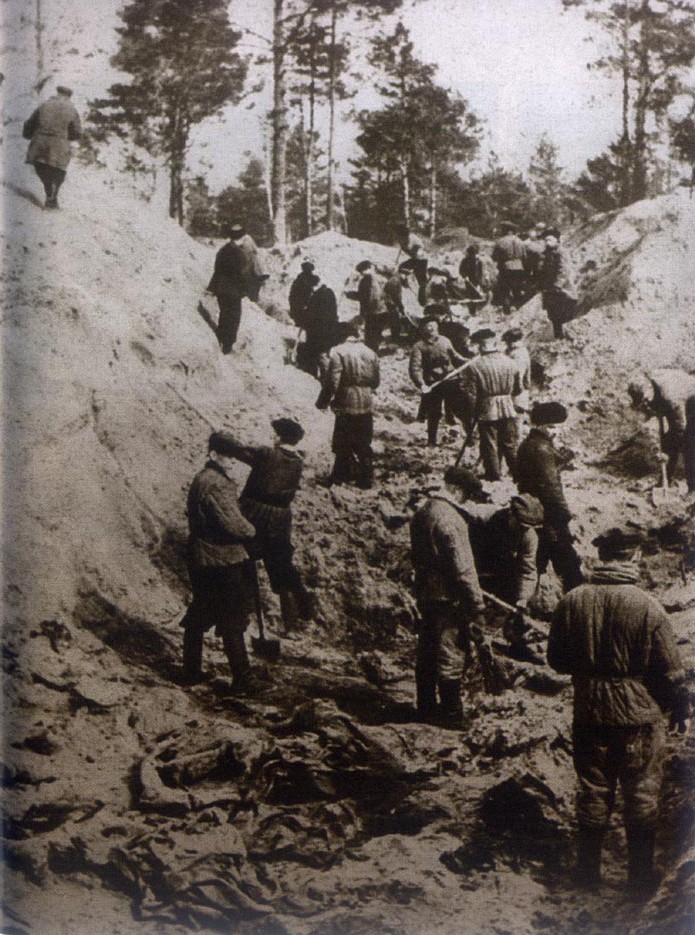On September 17, 1939, the Soviet army entered Poland as a consequence of the treaty concluded between the Third Reich and the Soviet Union on August 23, 1939, known as the Ribbentrop-Molotov Pact, after the names of the signatories. Soviet aggression sealed the fall of the Second Polish Republic. The Polish army fought fierce battles against Germany from September 1, 1939, but was not able to resist the troops of both invaders, partly due to the lack of any real help from France and Great Britain. On September 28, the Third Reich and the Soviet Union concluded a treaty regulating their new common border. Additional provisions of this document stated: “Both parties will not tolerate any Polish agitation in their areas affecting the other side’s territories. The parties will nip any such agitation in the bud on their territory and they will inform each other about their measures for this activity “
These arrangements were an introduction to the joint German and Soviet extermination of the Polish elite. Many Polish soldiers withdrew from the German army to the territories of eastern Poland occupied by the Soviet Union. Also, thousands of Polish police officers who left the areas occupied by the Germans found their way to the East. In total, over 200,000 soldiers and officers were taken prisoner as well as several thousand police officers, prison guards or soldiers of the Border Protection Corps (KOP).
The Soviet authorities immediately separated the officers from the rest of the soldiers. The officers, who formed the intellectual elite of Poland along with lawyers, doctors, teachers and officials, were directed to specially designated camps in Starobielsk, Kozielsk and in Ostashkov. Policemen, prison guards and soldiers of the KOP were imprisoned in Ostashkov.
In late autumn 1939, all prisoners of war were interrogated by officers of the Soviet security – NKVD. The questionings were aimed at probing whether the prisoners of war would be willing to agree to cooperate with the Soviets. The overwhelming majority did not agree to it. Those, who were accepted by the NKVD were transferred to other camps for their further indoctrination.
The POWs who remained in Kozielsk, Starobielsk and Ostashkov had the opportunity to correspond with their families remaining under German occupation. Letters from prisoners, most often postcards, were sent to their relatives until the spring of 1940. Later, contacts were completely lost.
At the beginning of March 1940, the head of the NKVD, Lavrentiy Beria, wrote a letter to the Soviet dictator Joseph Stalin:
“In the NKVD prisoner-of-war camps of the USSR and in prisons in the western oblasts of Ukraine and Belarus, there is currently a large number of former Polish army officers, former Polish policemen and intelligentsia, nationalists, members of exposed counter-revolutionary parties and insurgent organizations, refugees and others. They are all unrepentant enemies of the Soviet power, full of hatred for the Soviet system.”
Later in the letter, Beria asked Stalin to consent to the examination of cases held by the Special College of the NKVD (de facto quasi-court) under a special procedure, “with the capital punishment by shooting”. The special procedure meant there was no need to summon the detainees and present the charges and the indictment to them, as well as the decision to end the investigation. As suggested by Beria, the authorities of the Soviet Communist Party, headed by Joseph Stalin, approved the request. On the basis of this decision, the head of the NKVD ordered the murder of Polish prisoners of war, perfidiously writing about the mode of their extermination as “unloading” of their places of imprisonment.
The action of murdering Polish prisoners of war began on April 3 with the killing of POWs in Kozielsk. Two days later, the same criminal actions were taken in the remaining camps in Starobelsk and Ostashkov. The entire operation was carefully planned. The prisoners from Kozielsk were transported in tight railway carriages to the Gniezdovo station near Smolensk, from where they were packed on a prison bus that took them to the forest in Katyn. There, Poles were shot in the back of the head. The murdered Poles were buried in mass graves. Those crimes are called the Katyn massacre.
One of the Polish officers, Major Adam Solski, managed to note down before the murder:
“I was taken to the woods somewhere, sort of like a summer resort. Then followed a detailed revision. They took my watch which showed 6.30 am, rubles, a belt, a pocket knife. I was asked about my wedding ring… ”.
In total, 4,400 Poles were murdered in Katyn until May 13, 1940.
Prisoners from the Starobelsk camp were murdered in the basement of the NKVD building in Kharkiv and buried next to the village of Piatichatki. Ostashkov prisoners were murdered in the basement of the NKVD building located in Kalinin (today’s Tver) and were buried near the village of Mednoje.
The repressions also affected the families of the victims of the Katyn massacre, who lived in the territories occupied by the Soviet Union. On the night of April 12-13, 1940, that is exactly at the same time when the NKVD officers were murdering Polish prisoners of war, their relatives were deported deep into the Soviet Union, mainly to present-day Kazakhstan. In total, more than 60,000 people had to leave their places of residence, according to NKVD data. The decision to organize this deportation was made at the beginning of March 1940, exactly at the same time as the decision to murder the Polish prisoners of war.





